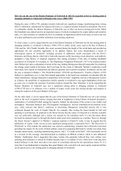How far can the case of the Demon Drummer of Tedworth of 1662 be regarded as the key turning point in
changing attitudes to witchcraft in Britain in the years c1580-1750?
During the years c1580-c1750, attitudes towards witchcraft saw significant change, transforming from a strong
belief in diabolism, underpinned by religious divisions, to a sceptical mindset fostered by rationalism. However,
it is debatable whether the Demon Drummer of Tedworth case of 1662 was the key turning point in this. While
this fraudulent case indeed acted as an important source of critical investigation for sceptic authors and scientists
alike, it is also necessary to consider the level of continuity in superstitious belief at this time, as well as the role
of sceptic publications and scientific institutions in promoting scepticism.
To some extent, it can be argued that the case of the Demon Drummer of Tedworth was the key turning point in
changing attitudes to witchcraft in Britain c1580-c1750 as unlike earlier cases, such as the Boy of Burton in
1596 and the 1634 Pendle Swindle, this event occurred during the height of the witch-hunts and provided an
opportunity for new scientific approaches to be applied. Indeed, this event demonstrated a variety of
stereotypical aspects of witchcraft, including accounts of sulphurous smells associated with the Devil’s
brimstone and flying objects, which led to Tedworth mansion swiftly becoming a local attraction; such publicity
prompted a long history of sceptical responses, thus raising awareness of the ease of making fraudulent
accusations of witchcraft. For example, in ‘The Displaying of Supposed Witchcraft’ (1677), the respected author
John Webster provides a substantial criticism of the case, holding Mompesson himself responsible for producing
the strange noises heard at the house; had it not been for the events at Tedworth, Webster’s scepticism would
most likely have lacked its foundations and failed to generate such a positive reception. In addition, the fact that
the case is attacked in Bekker’s ‘The World Bewitched’ (1592-94) and Beaumont’s ‘Treatise of Spirits’ (1705)
furthers its significance as it is clear that rational approaches to the fraud were sustained even decades after the
initial disturbances; through Beaumont’s proposition of the servants’ culpability and use of Mompesson’s letters
as evidence, the possibility of explanations entirely separate to witchcraft is once again highlighted, which may
go some way to explain the rejection of spectral evidence around this time. Therefore, it can be argued that the
Demon Drummer of Tedworth case was a significant turning point in changing attitudes to witchcraft
c1580-c1750 due to its influence over a number of sceptic works across the ensuing decades and integrity in
raising the suspicion of the great thinkers of the ages.
On the other hand, it can be argued that the case of the Demon Drummer of Tedworth was not a key turning
point as the level of popular interest, ranging from that of neighbours to King Charles II himself, prompted a
continuation of witchcraft beliefs among the majority. Indeed, the discussion of the events in two widely read
newspapers, ‘Mercurius Publicus’ and ‘The Kingdom’s Intelligencer’, heavily contributed to the notoriety of the
case, while rumours that Drury’s confession to bewitching Mompesson intensified interest; this is best
evidenced through the work of Joseph Glanvill. For example, after visiting the house himself in 1663 and
speaking to eyewitnesses, he proposed to the Royal Society that the study of witchcraft in a rational, scientific
way was achievable; although such a notion was rejected by the institution itself, it is true that many others
favoured his approach and it is through this that he made much of his reputation as a member. However, through
the Royal Society’s approval of Webster’s sceptical response to Glanvill’s work, it may be argued that the
publication of sceptic works served as more significant turning points, in particular Scot’s ‘The Discoverie of
Witchcraft’ in 1584. Indeed, this publication was central in undermining certainties that witchcraft existed and
providing the origins for the work of future authors, such as by proposing that harm by witches was solely done
through natural means, including administering poison; Ady’s ‘A Candle in the Dark’ (1656) essentially served
as a revision of this message, and demonstrated an emphasis on Biblical evidence which in turn influenced
Webster. Furthermore, Scot’s suggestion that many women who genuinely believed they were witches were
suffering from delusions is echoed by Hobbes decades later in ‘Leviathan’ (1651); while Scot’s work may have
lacked influence in the short term due to the extent of censorship enforced by the superstitious James VI, it is
clear that it was fundamental in inspiring later great thinkers who were able to be more openly sceptical and thus
can be perceived as a key turning point in changing attitudes to witchcraft.




